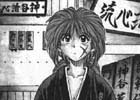Rurouni Kenshin by Kuzu Ryu Sen
Japanese Title: Rurouni Kenshin: Meiji Kenkaku Romantan
Also Known As: RK, RuroKen, Kenshin
Genre: Action/Drama
Length: 28 Volumes
Allegiance: Shueisha Ltd./Viz Communications
Mangaka: Watsuki Nobuhiro
Vintage: 1994-1999
Intelligence Agency Report by: Djudge
The violence of the Bakumatsu produced a legend so endearing that his name strikes fear in the hearts of men even years into the Meiji emperor’s rule. The infamous Hitokiri Battousai was a swordsman of amazing caliber whom single-handedly cut open the path to victory for the revolutionary Ishin Shishi movement. However after final victory over the Tokugawa Shogunate was attained, the legendary assassin disappeared into the shadows of time. In order to atone for the unspeakable crimes that he committed under the name of Battousai, Himura Kenshin, now a wandering rurouni, takes up a new crusade: to save as many innocent individuals as he can without ever taking another life.
<hr>
| Research Agent Report by: Kuzu Ryu Sen | ||
| Plot Characters Impact Visual |
8.50 9.25 9.25 8.00 |
|
| Overall | 9.00 | |
| (not an average) | ||
| In 1994, after writing a few short one-shots starring a feminine rurouni who had been based on the historic hitokiri Kawakami Gensai, Watsuki Nobuhiro had yet another story starring said rurouni featured inWeekly Shonen Jump. Titled Rurouni Kenshin, this work would eventually span twenty-eight volumes, finally ending in 1999 as one of the most popular titles in Japan. This was hardly surprising, given Rurouni Kenshin’s diverse and amicable cast, its powerful themes and plot, and Watsuki’s simple yet very effective art style.
From the very first few volumes, one could see that Rurouni Kenshin had all the aspects of a stereotypical shonen manga. Most of the characters did not have special personalities, and the simplistic art style characteristic of the genre did not help to distinguish Rurouni Kenshin from other shonen titles. However, what initially started as ordinary gradually began to transcend their stereotypes. Characters began to develop, themes started to appear, and the plot, which had been a “monster of the chapter” type story, began to condense as events started to tie together. As a result, the last twenty-one volumes ofRurouni Kenshin are masterful, featuring outstanding characterization of both leads (particularly that of Himura Kenshin) and supporting characters and a plot with plenty of twists and turns, particularly during the Kyoto Arc. However, there are a few things to beware of in Rurouni Kenshin. First and foremost, almost every major male character is based on an actual person in Japanese history, so knowledge in that area is somewhat important for the full Rurouni Kenshin experience. Also, while the plot may be very intricate and interwoven during the Kyoto Arc, it is somewhat straightforward before and after it. This isn’t a very large issue, since the Jinchuu Arc is built on conflict of emotions and ideologies rather than story, but it oversimplifies the last ten volumes somewhat. Finally, Watsuki’s art style, while good and fitting, has a habit of overusing straight line shading, as well as over stippling during battle- impact scenes. Rurouni Kenshin is something that strikes a chord with quite a few audiences. It has romantic elements, vicious action, a cast with a plethora of personalities, and a plot that will make anyone think, not to mention it seamlessly interweaves fact and fiction. Despite the somewhat simplistic opening and ending and the unrefined artwork, Rurouni Kenshin is still a great story and a window into Japanese culture and history. Small wonder that the series is still one of the most popular in Japan and in North America, even though five years have passed since the conclusion of its initial run.
|
||




